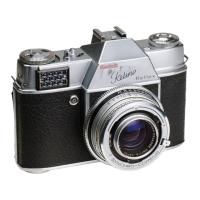Filters for Black-and-white Film
By its nature, a black-and-white film can only translate colour values of the subject into tones of lighter or
darker grey. Mostly these correspond fairly closely to the brightness of the colours, but do not of course
differentiate between them. In certain cases the difference between the brightness of two colours may be so
slight that both record in almost the same tone of grey.
There a filter helps by modifying the depth of one or the other colour, and so making it show up lighter or darker
than it would normally.
The commonest example is the blue sky with white clouds in a landscape. The blue is so brilliant (and the film is
often excessively sensitive to it) that the clouds do not show up against it. By putting a yellow filter in front of
the camera lens we can subdue or "hold back" the blue, so making it record darker in the final print. We can
even go further and over-emphasize the effect progressively with an orange or red filter; these darken the blue
so much that the sky looks almost black for a really dramatic effect.
The same considerations hold for other filter effects. For instance, the film renders a red rose in the same tone
of grey as the green leaves of the rose bush. With the colour contrast gone, the rose disappears in its
surroundings. A green filter makes the rose darker and the leaves lighter; conversely a red filter will show up the
rose as light against dark foliage. Scientifically, both filters falsify the tone rendering, but produce a more
acceptable pictorial result.
In all these cases a filter lightens objects of its own colour, and darkens objects of its complementary colour.
Apart from isolated instances in pictorial photography, such contrast control is very valuable in copying and
scientific work (e.g. photomicrography).
All filters cut out some part of the light and thus, as a compensation, an increase in exposure time is necessary
when using them. This is stated on most filters in the form of a filter factor indicating by how much (e.g. 2
times, 3 times), the exposure must be increased with that filter. The factors are approximate for they depend
not only on the nature of the filter but also on the exact colour sensitivity of the film and on the colour of the
prevailing light.
Filters for Colour Film
The normal yellow, orange and other filters for black-and-white film must never be used with colour films as
they would give the picture a strong overall colour tint.
In daylight and with daylight type film, only two filters are ever required. One is a haze filter, almost colourless
but for a slight straw tinge. It is usefully employed on hazy days and in high altitudes to avoid excessive
bluishness of the colour picture, especially with distant landscapes, seascapes and near water. This filter does
not call for any change in exposure. On dull days, a skylight filter compensates for the excessive coldness of the
colour rendering.
Either filter is also useful for colour photography with electronic flash as it produces somewhat warmer tones.
Conversion filters are used if a colour film, balanced for one type of light, should be used in another type of
light. The film manufacturers give specific recommendations, generally in the instructions with the film.
Polarizing Filter
There are times when the judicious use of reflections will enhance the pictorial effect of the picture, but they are
also frequently obtrusive and undesirable. Thus highly-polished subjects are difficult to illuminate successfully so
as to obtain a true photographic rendering, since they will reflect too much light and so spoil the reproduction
with a glare which obscures the detail. To overcome this difficulty the polarizing filter suppresses light
reflections from glass, china, enamel, polished wooden surfaces, water, etc.(but not metals.) This filter will
prove particularly useful when taking shop windows, furniture, photography of wet objects, etc. The effect is
greatest when the camera points at a reflecting surface at an angle of about 35°.
The filter must be rotated to find out its best position on the lens. The Retina Reflex camera is ideal for this
observation. The filter is simply held in front of the lens, and then slowly rotated to find the best or desired
result on the reflex-focusing screen. Push the filter on to the lens in the position selected. As the polarizing filter
is slightly tinted, the exposure time should be increased by a factor of 3.
The polarizing screen is, in addition, particularly useful in colour photography where it acts similarly to the
yellow filter in black-and-white photography, i.e. it darkens a "milky" blue sky. The bluish colour cast obtained
with diffused sky light is removed or at least appreciably reduced with the polarizing filter. The reduction or
elimination of reflections through this filter is of course just as useful in colour pictures as it is in black-and-
white.
EXPOSURE
Exposure means -- to expose the film in your camera to light. The dose of light any film needs to produce the
right sort of image depends on how sensitive that film is to light. A fast film is more sensitive than a slow film.

